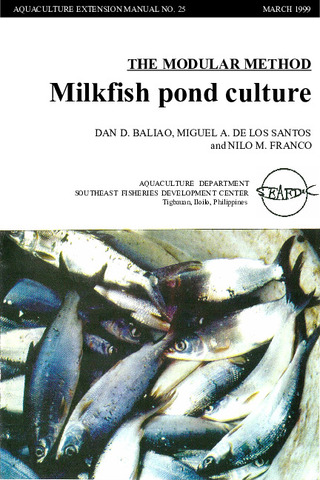Broodstock management and egg production of milkfish, Chanos chanos Forsskal
- Global styles
- MLA
- Vancouver
- Elsevier - Harvard
- APA
- Help
Share
Abstract
The milkfish, Chanos chanos Forsskal, industry in the Philippines suffers from a limited supply of wild fry. The demand for milkfish fry has spurred research in artificial propagation to supplement the natural seed supply. Spontaneous maturation and spawning of milkfish beginning at 5 years of rearing in floating net cages or concrete tanks coupled with improved egg collection technique have increased daily egg collection to a maximum of 3 million eggs and provided adequate volumes of eggs for mass fry production. Annual egg collection and number of spawnings were markedly higher in cage-reared stocks older than 9 years old than stocks less than 9 years old. Egg collection of tank-reared stocks were comparable to those collected in cages. As feed constitutes a major portion of the operating expenses for establishing and maintaining milkfish broodstock, further studies must be geared towards defining optimum dietary requirements and ration size for gonadal maturation and spawning. Also environmental manipulation studies must be conducted for year-round spawning. Developments in these areas should ensure the production of maximum numbers of high quality eggs and fry year-round.
Suggested Citation
Emata, A. C., & Marte, C. L. (1993). Broodstock management and egg production of milkfish, Chanos chanos Forsskal. Aquaculture Research , 24(3), 381-388. https://doi.org/10.1111/j.1365-2109.1993.tb00561.x
Type
ArticleISSN
1365-2109Collections
- Journal Articles [1258]
Related items
Showing items related by title, author, creator and subject.
-
Series: Aquaculture extension manual; No. 25
The modular method: Milkfish pond culture
Baliao, Dan D.; de los Santos, Miguel A.; Franco, Nilo M. (Aquaculture Department, Southeast Asian Fisheries Development Center, 1999)The modular method of milkfish culture (Chanos chanos) described in the manual is an improvement over the traditional extensive method. The manual is intended for the use of fish farmers and aquaculturists, extensionists, ... -
Evaluation of organic and inorganic fertilizers in brackishwater milkfish ponds
Bombeo-Tuburan, Isidra; Agbayani, Renato F.; Subosa, Precilla F. (Elsevier, 1989)The study was conducted in twelve 144-m2 ponds to evaluate the effect of different organic and inorganic fertilizers on the growth, survival, gross production, and profitability of marketable milkfish. The ... -
Milkfish breeding and hatchery technology at SEAFDEC/AQD
Unknown author (Aquaculture Department, Southeast Asian Fisheries Development Center, 1999)Describes the techniques already adopted by the private sector: broodstock management, broodstock diet, commercial fry production, live transport, and larval diet. A list of AQD research publications on milkfish is included.






